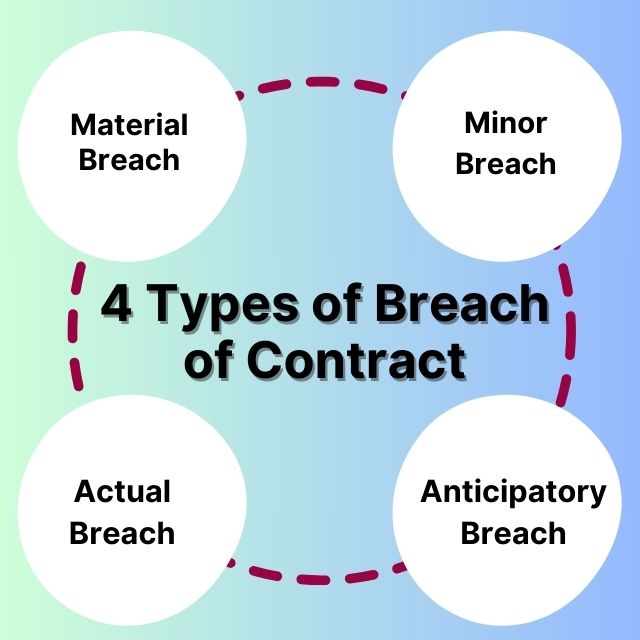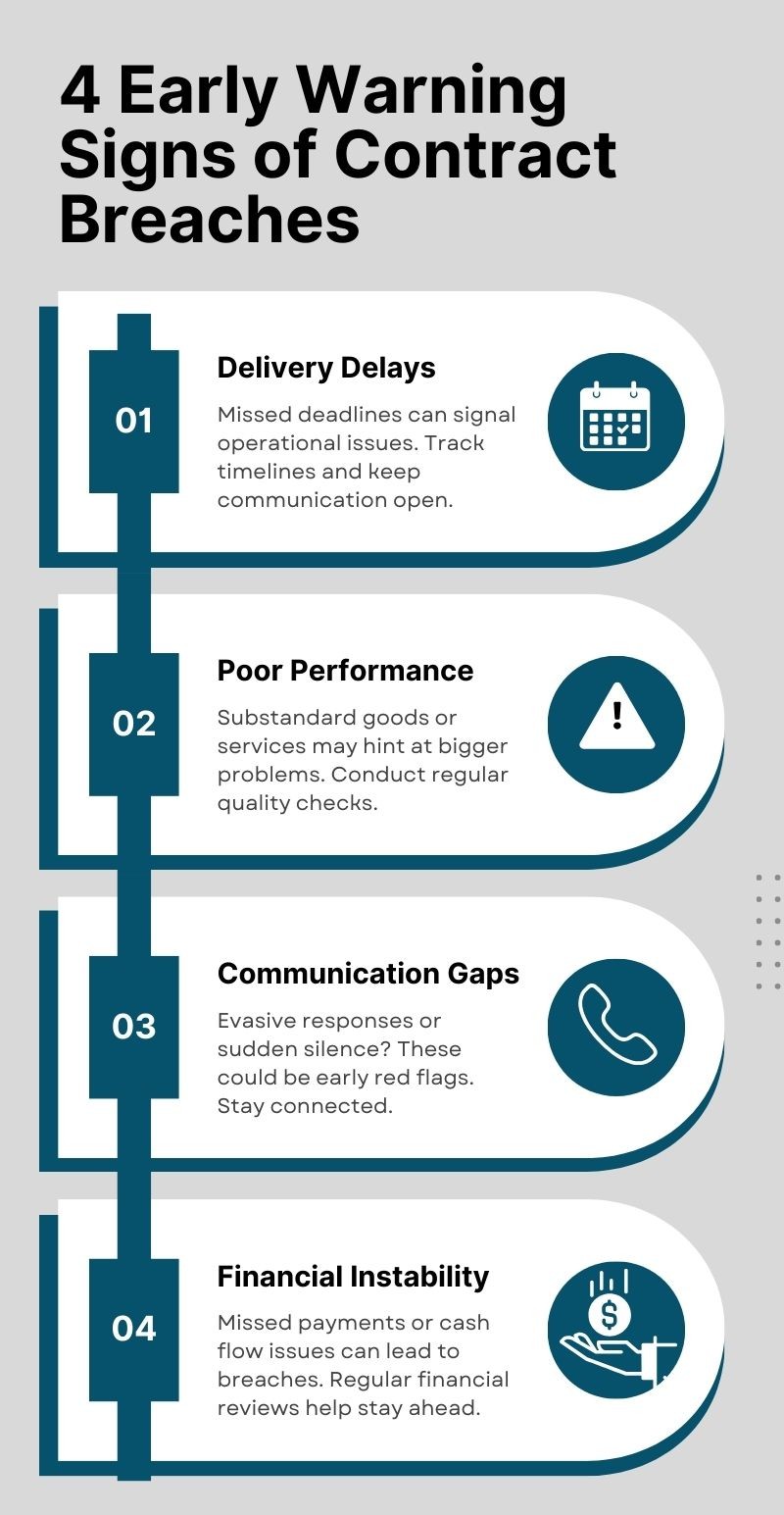In the intricate and interconnected world of modern business, contracts are more than mere formalities; they are the bedrock upon which commercial relationships are built and maintained. These legally binding agreements lay out the expectations and responsibilities of all involved parties, offering a roadmap for successful business operations. For senior business leaders, navigating the landscape of contractual obligations is a fundamental aspect of their role. These leaders are often at the helm, steering their organizations through a sea of agreements ranging from supplier contracts, partnership agreements, to high-stakes mergers and acquisitions.
The concept of breach of contract, where one or more parties fail to meet their contractual obligations, is a critical area for these leaders to understand thoroughly. Such breaches can have far-reaching implications, not just legally, but also in terms of business relationships, reputation, and financial health. A breach of contract can derail strategic objectives, disrupt operations, and potentially lead to significant legal and financial consequences. Therefore, a comprehensive understanding of what constitutes a breach, its potential impact, and strategies for its resolution is indispensable for senior business leaders.
This article aims to serve as an exhaustive guide in this regard, offering insights into the nuances of breach of contract. It is designed to equip business leaders with the knowledge to effectively manage and mitigate the risks associated with contractual breaches. Through this detailed exploration, leaders can learn not only how to navigate these challenges when they arise but also how to put in place proactive measures to avoid such situations, thereby safeguarding their organization’s interests and ensuring its ongoing success in the competitive business arena.
Breach of Contract Definition and Types
In the realm of business, a breach of contract represents a fundamental failure in the adherence to agreed-upon terms between parties. This breach can manifest in various forms, each carrying its own set of implications, challenges, and potential remedies. Understanding these different types of breaches is crucial for senior business leaders to effectively navigate and manage contractual relationships.

Material Breach
A material breach is a significant failure that strikes at the heart of the contract. It occurs when one party’s failure to perform its obligations is so substantial that it impedes the contract’s very purpose. This type of breach can have severe repercussions, potentially rendering the entire contract void. For instance, if a supplier fails to deliver a key component of a product, preventing its manufacture and sale, this would be considered a material breach.
The consequences of such a breach are profound, often leading to major financial losses, legal disputes, and damage to business relationships.
Minor Breach
In contrast, a minor breach, sometimes referred to as a partial breach, is less severe and does not entirely invalidate the contract. It occurs when there is a slight deviation from the contractual terms, which doesn’t significantly affect the contract’s overall intent. An example could be a minor delay in delivery or a slight deviation from agreed specifications. While such breaches might not be as critical as material breaches, they still require attention and appropriate action, such as seeking compensation for any incurred losses or delays.
Anticipatory Breach
An anticipatory breach happens when one party indicates in advance that they will not fulfill their contractual obligations. This could be through a direct statement or by actions that make it clear that they will not be able to meet their contractual duties. Anticipatory breach allows the non-breaching party to take action before the actual time of performance, such as seeking alternative solutions or initiating legal proceedings. This type of breach is particularly challenging as it requires immediate strategic planning to mitigate potential damages.
Actual Breach
An actual breach is the failure to perform obligations precisely when they are due. This breach is clear-cut and leaves little room for interpretation, occurring at the moment a contractual duty is unmet. For example, if a payment is due on a specific date and it is not made, this constitutes an actual breach. The ramifications of such breaches depend on their severity and the specific terms of the contract, often leading to claims for damages or specific performance.
Understanding the Nuances
Grasping the nuances of these various types of breaches is essential for business leaders. Each type requires a different strategic approach and a keen understanding of legal and financial implications. Material and actual breaches typically demand more immediate and decisive action, possibly involving legal remedies. Minor and anticipatory breaches, while perhaps less severe, still require careful management to prevent escalation and preserve business relationships.
In dealing with breaches, it’s crucial to consider the contract’s language, the surrounding circumstances, and the potential impact on the business. Leaders must be adept at not only recognizing the type of breach but also at evaluating its potential impact and strategizing an appropriate response. This understanding is vital in safeguarding an organization’s interests and maintaining the integrity of its contractual engagements.
Recognizing the Signs of Potential Contract Breaches
For senior business leaders, early detection of signals indicating potential contract breaches is a crucial skill. This foresight allows for timely interventions that can mitigate risks and minimize damages. Key indicators of impending breaches include:

- Delays in Delivery or Performance: Persistent tardiness in meeting deadlines or delivering milestones can be a red flag. It often suggests operational challenges or mismanagement that might lead to a breach. Monitoring timelines closely and maintaining open communication lines with partners can help in identifying and addressing these issues early.
- Substandard Performance or Quality Issues: If the goods or services provided fall short of the agreed-upon standards or specifications, it may not only signal a minor breach but also foreshadow more significant problems. Regular quality checks and feedback sessions can help in spotting these discrepancies early on.
- Communication Breakdowns: A sudden drop in communication or a pattern of evasive or unclear responses can indicate problems. Effective and consistent communication is the backbone of any contract, and any disruption can be a precursor to a breach.
- Financial Instabilities: Signs of a party’s financial distress, such as missed payments, reports of cash flow problems, or credit rating downgrades, can forewarn of their inability to fulfill contractual obligations. Staying informed about the financial health of contractual partners through regular reviews and financial audits is essential.
Recognizing these signs requires a proactive approach, combining vigilance with strategic planning. It involves continuously monitoring contractual relationships and maintaining open lines of communication. By identifying these early warning signs, leaders can take pre-emptive actions to address issues before they escalate into full-fledged contract breaches. This proactive stance not only safeguards the company’s interests but also contributes to the stability and reliability of its business operations.
Remedies for Breach
When a breach of contract occurs, the law provides several remedies to the non-breaching party. These remedies are crucial in ensuring that justice is served and that the aggrieved party is compensated for their losses.
- Damages: The most common remedy for a breach of contract is the award of damages – monetary compensation for the loss incurred due to the breach. Damages are intended to put the non-breaching party in the position they would have been in had the breach not occurred. There are various types of damages, including compensatory, punitive, nominal, and liquidated damages. Compensatory damages cover the direct losses and costs incurred, while punitive damages are intended to punish willful or malicious misconduct and deter others from similar conduct.
- Specific Performance: In certain cases, monetary compensation is not an adequate remedy. Specific performance can be sought, which is a court order compelling the breaching party to fulfill their obligations under the contract. This remedy is particularly common in contracts involving unique items or properties, where monetary compensation would not suffice.
- Cancellation and Restitution: Cancellation and restitution involve the termination of the contract and the restoration of the non-breaching party to their pre-contractual position. This remedy is often sought in cases where the breach fundamentally undermines the entire contract, making its continuation untenable.
- Evaluating the Impact: Evaluating the impact of a breach is a critical step in determining the appropriate course of action. This involves assessing the direct financial losses incurred, such as lost profits or additional costs. However, it’s equally important to consider indirect losses, such as reputational damage, loss of trust among stakeholders, and the potential negative effects on future business opportunities. A thorough evaluation helps in deciding whether to pursue legal action and what form of remedy to seek.
Strategic Responses to a Breach
Internal Assessment: Upon suspicion of a breach, it’s imperative to conduct a comprehensive internal assessment. This involves collecting and reviewing all contract-related documents, including correspondence and performance records, to understand the scope and specific details of the breach. A meticulous assessment aids in forming a factual basis for any subsequent legal actions or negotiations.
Communication Strategies: Effective communication plays a pivotal role in managing a breach of contract situation. It’s advisable to engage in direct but professional dialogue with the breaching party. Clear and tactful communication can often lead to a better understanding of the issues at hand and pave the way for amicable resolutions. Avoiding accusatory language helps maintain a constructive atmosphere, which is beneficial for negotiations.
Legal Consultation: Consulting with legal counsel early in the process is crucial. An experienced attorney can provide strategic advice, assist in navigating complex legal frameworks, and advocate on behalf of the non-breaching party. Legal expertise is invaluable in evaluating the merits of the case, exploring potential remedies, and guiding the decision-making process.
Negotiation and Resolution: Many disputes arising from breaches of contract can be resolved through negotiation, which is generally quicker and more cost-effective than litigation. Negotiation allows for more flexibility and creativity in finding a mutually acceptable resolution. It’s an opportunity to address the underlying issues, repair business relationships, and potentially agree on revised terms that are satisfactory to all parties involved.
Mitigating the Risks
- Robust Contract Drafting: Prevent breaches through meticulous contract drafting. Ensure clarity in terms, conditions, and obligations.
- Due Diligence: Before entering agreements, conduct comprehensive due diligence to assess the other party’s reliability and financial stability.
- Regular Monitoring: Regularly review and monitor contractual relationships. This proactive approach can help in identifying and addressing issues early.
- Training and Compliance: Ensure your team is well-trained in contract management and compliance. Understanding contractual obligations reduces the risk of unintentional breaches.
Future Trends in Contract Management
In an era marked by rapid technological advancement and increasing globalization, the landscape of contract management is evolving dramatically. Senior business leaders must stay abreast of these changes to ensure effective and efficient contract management. Two key trends shaping the future of this field are the integration of technology, particularly AI and blockchain, and the growing complexity of international contract law due to globalization.
Technology in Contract Management
- AI-Driven Contract Analysis: Artificial Intelligence (AI) is increasingly being utilized in contract management for its ability to analyze large volumes of data quickly and with precision. AI can review contracts in a fraction of the time it takes humans, identifying risks, obligations, and opportunities that might be overlooked. This technology is also adept at predicting potential contract disputes based on historical data, enabling proactive management of agreements.
- Blockchain for Contract Security and Execution: Blockchain technology is being heralded as a game-changer for contract management. Its most significant contribution is in creating secure, immutable records of contracts, which can greatly reduce the incidences of fraud and unauthorized alterations. Smart contracts, which are self-executing contracts with the terms of the agreement directly written into code, are an innovation in this space. They can automatically enforce and execute contract terms, reducing the need for intermediaries and increasing efficiency.
Globalization and Contract Law
- Navigating Multiple Jurisdictions: Globalization has led businesses to operate across multiple jurisdictions, each with its own legal system and contractual norms. This complexity necessitates a robust understanding of international contract law. Companies must navigate different legal frameworks and cultural nuances in contract negotiations and enforcement.
- Cross-Border Contractual Challenges: Contracts that span different countries can be subject to various international laws and regulations, which can complicate enforcement and dispute resolution. There’s a growing need for harmonization of contract laws, or at least, for businesses to develop strategies that can accommodate these differences. This includes understanding international arbitration mechanisms and the enforceability of contracts across borders.
- Adaptability to Local and Global Changes: Business leaders must be adaptable to both local and global changes in law and policy that can impact contract management. This includes keeping abreast of changes in trade agreements, international sanctions, and regional regulatory shifts.
The future of contract management is intertwined with technological innovation and the complexities of global operations. By embracing AI and blockchain technologies, business leaders can enhance the efficiency, security, and effectiveness of contract management. Simultaneously, a deep understanding of the nuances of international contract law is essential to navigate the challenges of a globalized business environment. Staying ahead in this dynamic landscape requires continuous learning and adaptation, ensuring that businesses can leverage these trends to their advantage.
For senior business leaders, developing a deep understanding of breach of contract dynamics transcends mere legal compliance; it is an essential component of strategic leadership and organizational resilience. The ability to navigate the complexities of contractual breaches involves more than just a reactive stance; it requires a proactive, informed, and strategic approach to safeguard an organization’s interests and guide it towards long-term success.
Understanding the nuances of breaches is the first step in this process. This knowledge enables leaders to identify potential risks and vulnerabilities in their contracts and relationships. By being aware of the various types of breaches – material, minor, anticipatory, and actual – and their potential impacts on business operations, leaders can develop strategies to avoid or mitigate these risks.
Implementing robust preventive measures is equally crucial. This includes crafting clear, comprehensive contracts with well-defined terms and conditions, performing due diligence before entering agreements, and regularly monitoring and reviewing contractual relationships. Prevention also involves educating and training team members on the importance of contract compliance and the implications of breaches.
However, even with the best preventive strategies, breaches can and do occur. Therefore, being prepared for effective management and resolution is imperative. This preparation involves having a clear plan for handling breaches, which could include internal assessments, open and clear communication with the involved parties, and, where necessary, legal consultation and action.
In this evolving business world, staying informed and adaptable is key. This includes embracing technological advancements in contract management, such as AI and blockchain, which can provide sophisticated tools for monitoring, analysis, and enforcement of contracts. These technologies can enhance the accuracy and efficiency of contract management processes, offering business leaders an edge in handling complex contractual landscapes.
In summary, for senior business leaders, mastery of breach of contract is not merely a legal obligation but a core element of strategic business management. By combining a deep understanding of contractual nuances, implementing preventative measures, preparing for effective resolution, and leveraging technology, leaders can protect their organizations and navigate the intricate world of business contracts with confidence and foresight.
Did you find this Legitt article worthwhile? More engaging blogs about smart contracts on the blockchain, contract management software and electronic signatures can be found in the Legitt Blogs section. You may also contact Legitt to hire the best contract lifecycle management services and solutions.
FAQs on Breach of Contract
What is a breach of contract?
A breach of contract occurs when one party fails to fulfill their obligations as stipulated in a contract. This can be a material or minor breach, and it can be anticipatory or actual.
What are the main types of contract breaches?
There are four main types: Material Breach (significant failure), Minor Breach (less severe), Anticipatory Breach (indication of future non-compliance), and Actual Breach (failure to perform when due).
How can a business leader recognize a potential breach?
Look for early signs like delays, substandard performance, communication breakdowns, or signs of financial instability from the other party.
What legal remedies are available for a breach of contract?
Remedies include damages (monetary compensation), specific performance (court-ordered fulfillment of obligations), and cancellation with restitution (contract termination and restoration to pre-contract status).
What steps should be taken internally when a breach is suspected?
Conduct a thorough internal assessment, gather all relevant documents, and evaluate the breach's impact.
How important is communication in resolving contract breaches?
Effective, professional communication is crucial. It helps maintain a constructive dialogue and can lead to faster, amicable resolutions.
Why is legal consultation important in breach of contract scenarios?
Legal experts provide strategic advice, help navigate complex legal landscapes, and can represent your interests in negotiations or court.
What role does due diligence play in contract management?
Due diligence helps assess the reliability and financial stability of potential partners, reducing the risk of contract breaches.
How can technology aid in contract management?
Technologies like AI and blockchain offer improved contract tracking, automated compliance checks, and enhanced risk assessment capabilities.
What should be considered in contract drafting to prevent breaches?
Ensure clarity in the contract's terms, conditions, and obligations. Clear and thorough contracts can prevent misunderstandings and unintentional breaches.

